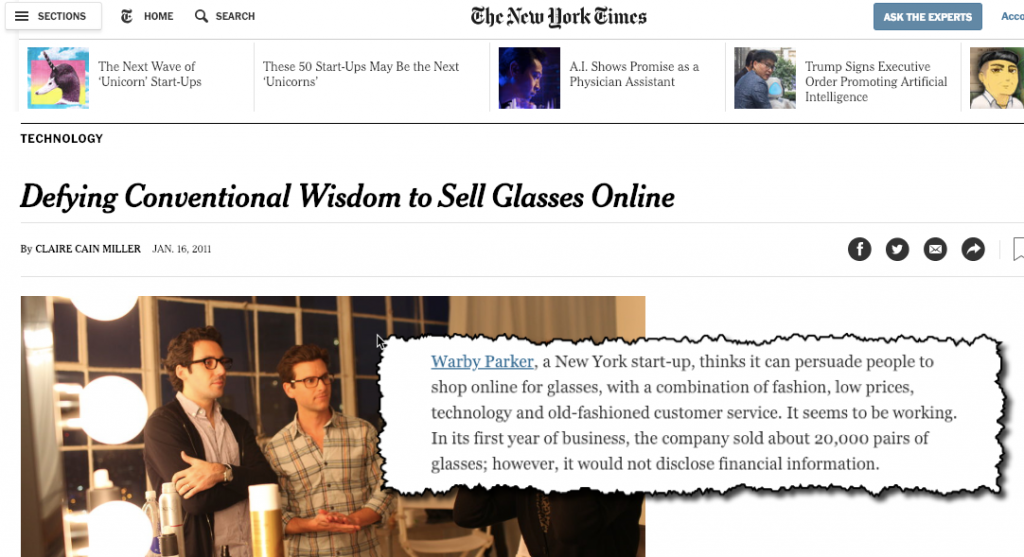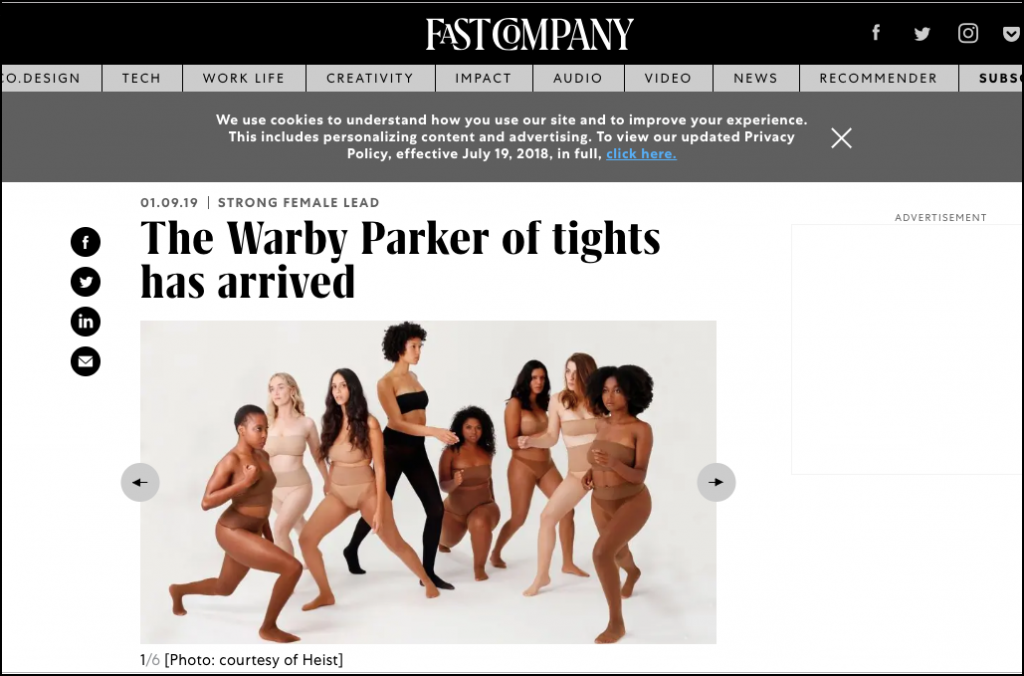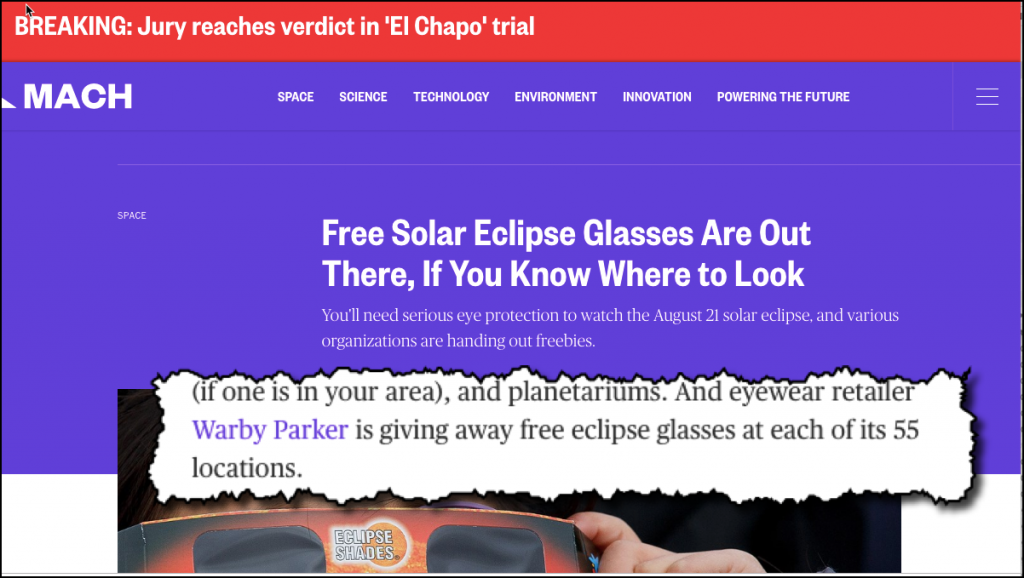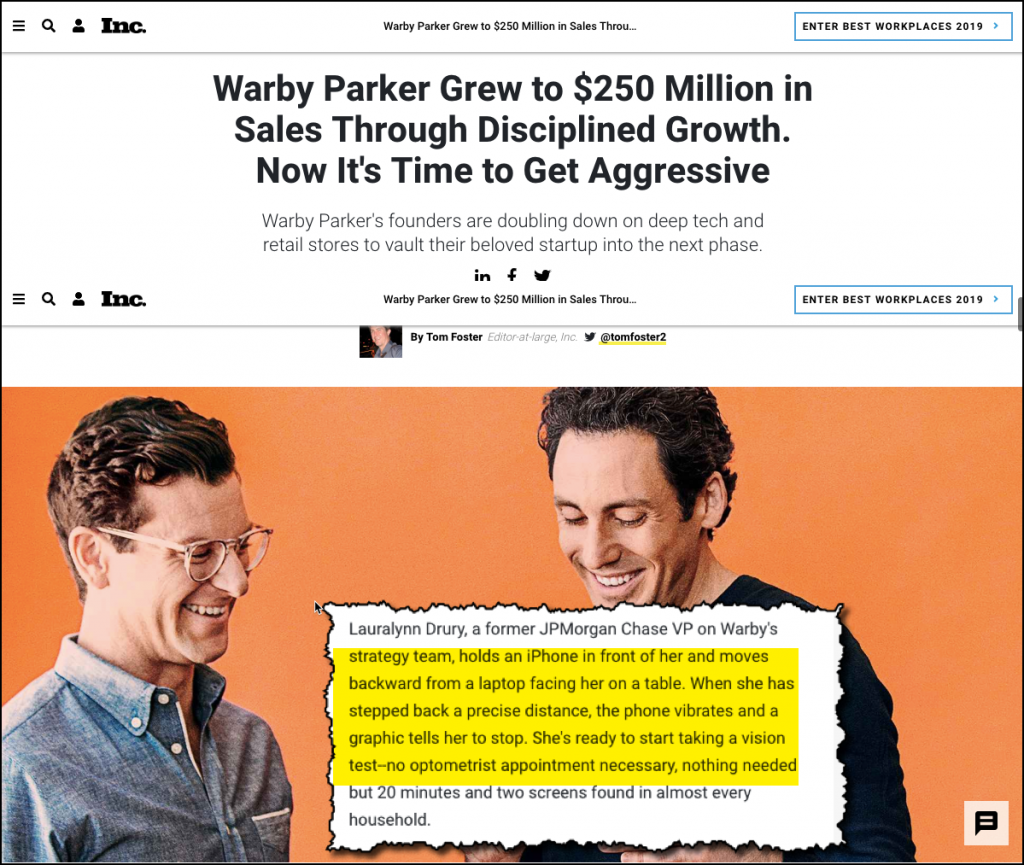
Multiple editorial links have contributed to a fantastic link profile for eyewear company, Warby Parker that has grown from zero to annual sales of $250 million. One driver of this growth is surely their adeptness at generating newsworthy copy from a host of major media sites. We asked former Financial Times reporter, Iain Cognito to take a look at the company’s coverage.
When Warby Parker co-founder Dave Gilboa was a business school graduate student, he lost his glasses while backpacking and couldn’t afford to replace them. That scenario led him and some of his Wharton classmates to figure out that the prescription eyewear industry could stand a little modernisation, or in the jargon of the time, disruption.
Although not yet 10 years in existence, the eyewear group has now elbowed its way into the US business consciousness in a manner that belies its size.
Editorial links don’t happen by accident
By selling vintage-inspired eyeglasses and sunglasses directly to consumers worldwide through its website and retail stores around the US, the company can offer high-quality glasses for around $95 a pair.
In the process, it has become a recognised “disruptor” in the market place, garnering recognition from the Nasdaq exchange and business media group CNBC, NY Times and Forbes magazine, among many others.

None of this happened by accident, though. Gilboa and one of his co-founders, Neil Blumental devised a carefully crafted strategy based on three fundamental pillars: the glasses, a website and a public relations team.
This meant acquiring the skills necessary to navigate the disparate social platforms, from Instagram, to Facebook and Twitter, among others. Warby has harnesses the skills of an outside agency, while also retaining and developing an in-house team.
Healthcare or fashion market?
An added difficulty for Warby Parker was that the sector they chose was in heavily regulated one of healthcare. This means that innovation and practice face a constantly over-arching legal environment that can stymie growth. This was evident in the controlled roll-out of their App to check eyesight, among others, where US states have different regulations covering “tele-medicine”. Apart from functionality, the eyewear market is essentially part of the fashion sector. That is evident in the eye-watering prices of some glasses. Warby has sought to maintain a cool, fashionable image, while keeping an eye on the bottom line of the price of glasses.
It has even managed that rare feat of its name’s becoming a synonym for quality from articles in the FastCompany website on a textile group’s new range of nylon stockings was headlined the “Warby Parker of tights” and another “The Warby Parker of cowboy boots”.

It was almost as if the name Warby Parker conjured up sufficient kudos to know that it meant success. This is Rolls-Royce territory.
It’s a testament to what Warby Parker has achieved in short period of time – namely reimagining the market for prescription glasses and build a distinctive profile in a competitive environment. It currently has about 65 outlets in the US, mainly in the New York and eastern area and employs about 1,500 staff.
Check out our plans and pricing starting at $49.99 (£39.99) per month!
Even hiring policy attracts editorial links
Even its left-field hiring policy has attracted interest from recruitment sites. Interviewees are often asked unusual questions, for example, “what was the last costume you wore”. “If we hire the most technically skilled person in the world whose work style doesn’t fit here, they won’t be successful,” Gilboa has said by way of explanation.
The company has also managed to burnish its strong social credentials along the way with its programme to give a pair of glasses to a poorer recipient for everyone it sells. Some media outlets estimate that it has given away more than 1 million pairs of glasses through partnering for a non-profit..
Not surprisingly, this has garnered Warby much positive coverage in the media and the company name (incidentally, derived from two Jack Kerouac characters) pops up across a number of sites.
These include consumer sites, business entrepreneurial ones, educational, start-up sites, medical/diagnostic. In fact, quite a range.
It uses social media platforms o promote a range of subjects, from its own products to ‘spoof’ adverts and memes, designed to leaven the mix.
It has also attracted good publicity – and editorial links – from “bigger fish” in the media. The BBC, New York Times and the Wall Street Journal, to name a few. And NBC reported their clever offer of free Solar Eclipse Glasses.

The company was founded in 2010 as a start-up by four Wharton graduates and now employs nearly 1,500 people. Financial information for the company is scarce because it is not publicly listed. Looking to the future, however, senior management are warm to the idea of an initial public offering.
Obviously, a public listed company is not the panacea to all funding problems and comes with a burdensome layer of extra regulation and scrutiny. In the meantime, Warby Parker is content with the private fundraising route.
After a private fundraising round last year of $75 million, Warby Parker is estimated by the New York Times to be worth about $1.7bn. Fundraising is vital for non-public companies as without the cash to expand, they soon run into trouble. The paper added that Warby Parker had added a professor from Harvard Business School to their board of directors. These developments are viewed very positively by the NYT, which sees them as further signs of the company’s successful foothold in the market.
Disrupters at work
As one would expect, the pair researched their market very carefully. Indeed, their research showed that the market was controlled by a few large companies that had historically kept prices for frames and prescription lenses artificially high. (razor blades, anyone?)

It also seemed to them that it was a natural market for disruption, that great, arguably the only coherent business to emerge in the past 25 years.
Uber, Spotify, Snapchat, Airbnb and Dropbox are some of the many companies that have managed to create a new market that threatens existing legacy players, according to tech exchange Nasdaq. Warby Parker joins them on the list, albeit not quite a ubiquitous name as their counterparts.
But where Warby Parker has scored high is in the name recognition of both principal CEOs. It has allowed them to take part in non-product-related interviews of a broader nature, for example on general employment issues.
Social media is also used to engage directly with consumers, a key point. They have even asked their subscribers to pick new glasses for their own employees.
This higher profile is deftly woven into the fabric of the PR offerings: two young (bespectacled) entrepreneurs, disrupting an existing established market, to the benefit of consumers, as well as themselves.
Maybe Roll-Royce should be the Warby Parker of cars!
Check out our plans and pricing starting at $49.99 (£39.99) per month!
- Editorial Links are just part of business for Warby Parker - February 7, 2019






